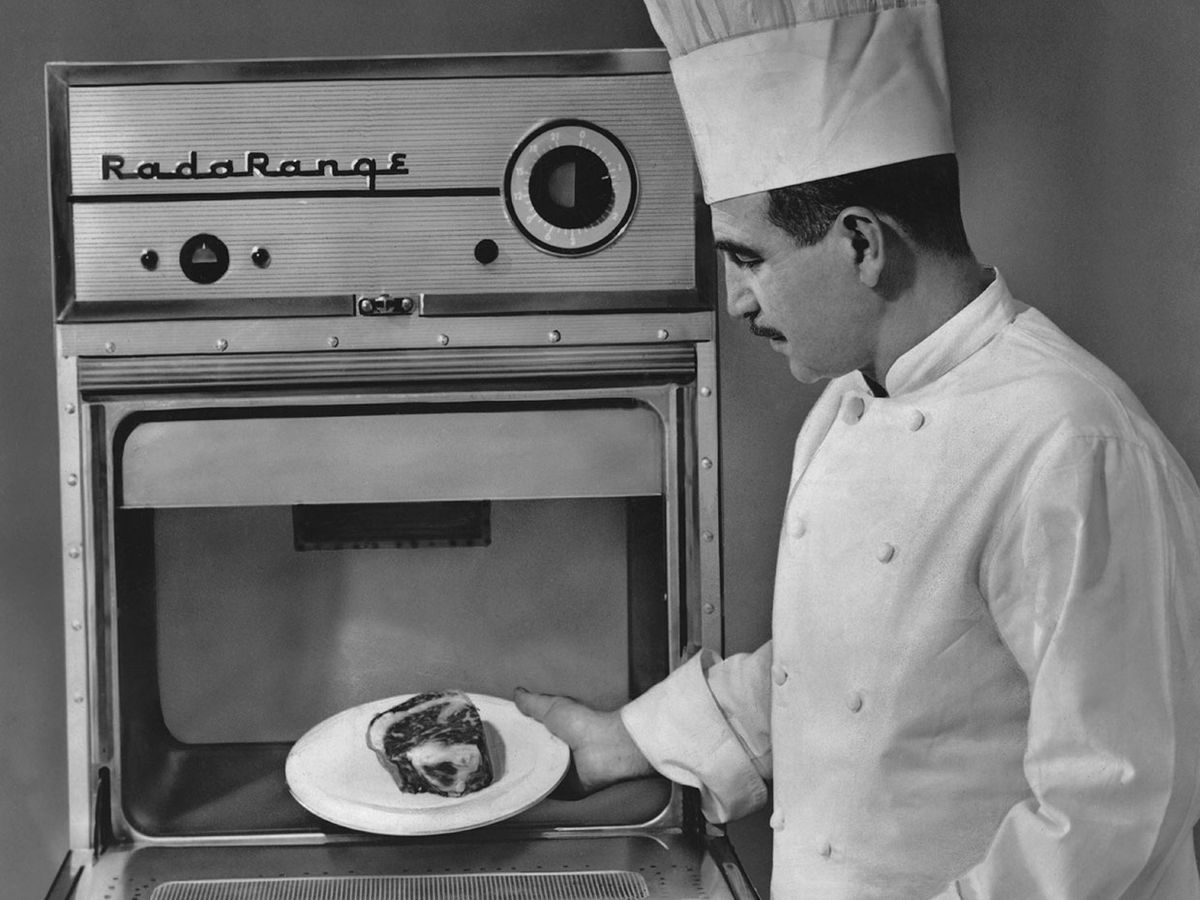THE INSTITUTEMelted chocolate in a scientist’s pocket in 1946 led to the development of an appliance that changed the way many of us cook our meals today. Percy L. Spencer, a researcher at Raytheon in Waltham, Mass., was testing communications equipment when he noticed that his candy bar heated up when he stood near a magnetron, a vacuum tube that produces microwave energy.
Spencer and other researchers at the company spent the next few months developing what was to become the first microwave oven. Raytheon unveiled the appliance—called the Radarange because the magnetron is the source of microwaves in a radar set—the following year. It sold for about US $5,000 (equivalent to approximately $64,000 today) and was marketed to commercial kitchens. It took more than 25 years for the appliance to become small enough and affordable enough to be a household staple. Despite some safety concerns, by the mid-1970s millions of microwave ovens were being sold to consumers each year.
FROM LAB TO KITCHEN
Microwave ovens heat food by exposing it to high-frequency microwave radiation. The ovens’ dielectric heating process induces polar molecules in the food, particularly those in water, to rotate and produce thermal energy.
Raytheon’s microwave oven was not the first device to exploit radio waves to heat things. In the early 1930s, short wavelengths were first used to heat human tissue in diathermy machines, used to treat rheumatoid conditions such as arthritis. At the 1933 Chicago World’s Fair, Westinghouse cooked steak and potatoes in minutes by placing them between two metal plates attached to a 10-kilowatt shortwave transmitter.
After Spencer’s candy bar melted he decided to experiment: He placed popcorn kernels near the magnetron and watched as they sputtered, cracked, and popped all over his lab. He then fashioned a metal box with an opening into which he could feed microwave power. Unable to escape, the energy in the box produced a higher density electromagnetic field. Food placed in the box and exposed to the microwaves rapidly got hotter.
Later in 1946, Raytheon filed for a patent for a microwave oven that could cook food. Marvin Bock, an engineer at the company, built an appliance that would become the Radarange. It relied on an output power of 1.6 kW from a water-cooled, permanent-magnet magnetron. A prototype, which was almost 2 meters tall and weighed about 340 kilograms, was installed in a Boston restaurant for testing. The following year, the Radarange hit the market. It sold in limited quantities to restaurants and commercial kitchens, some of which used the machine to dry potato chips and roast coffee beans and peanuts.
In 1955 Raytheon marketed a slightly smaller 220-volt wall unit for the home, at a price of $1,295 (about $11,440 today). It did not sell well. Sharp developed the R-10, Japan's first microwave oven in 1961. The following year, Sharp became the first company to mass produce microwave ovens.
Raytheon in 1965 acquired Amana, an appliance company in Newton, Iowa. In 1967, the first Amana home microwave oven, a 110-volt countertop model, sold for $495 (about $3,515 today). It was some 40 centimeters tall, 50 cm wide, and 30 cm deep. This popular version paved the way for the smaller, cheaper microwave ovens in use today.
SAFETY CONCERNS
Around the time that consumers began buying microwave ovens, federal regulations became an issue. The Radiation Control for Health and Safety Act of 1968 limited the amount of microwave energy that could leak from an oven throughout its lifetime to 10 milliwatts of microwave radiation per square centimeter (mW/cm²) at 5 cm from the oven’s surface.
The microwave oven industry, represented by the Association of Home Appliance Manufacturers (AHAM), felt it was meeting this spec. The oven doors, which were most susceptible to microwave leakage, were designed to limit microwave radiation values to less than the accepted tolerance of 10 mW/cm². Further, the doors were protected with interlocked switches that disabled the microwave power source should someone accidentally open the oven while it was on.
But a government study conducted at Walter Reed Hospital, in Washington, D.C., found that an alarmingly high percentage of ovens were leaking microwave energy. And the amount often was far in excess of 10 mW/cm².
In 1970 the U.S. Bureau of Radiological Health set the legal maximum radiation leakage level to 1 mW/cm² or less when the appliance was new and no more than 5 mW/cm² during its lifetime.
AHAM was not pleased. It protested that there was no basis for lowering the existing standard. Doing so, it said, would only increase manufacturing costs. The association also claimed the new restrictions would hinder the widespread use of the appliance.
Those fears proved unfounded. In the United States, the number of units sold each year climbed from 40,000 to 1 million by 1975. The ovens were even hotter sellers in Japan. By 1976, 17 percent of Japanese families reported they owned one, compared with 4 percent in the United States. By 1986, roughly 25 percent of U.S. households owned a microwave oven, and that number increased to 90 percent by 1997, when the average price was about $200.
The Engineering and Technology History Wiki offers more information about the history of the microwave oven and the standards that make the appliance safe to use today.
This article was written with assistance from the IEEE History Center, which is funded by donations to the IEEE Foundation.
